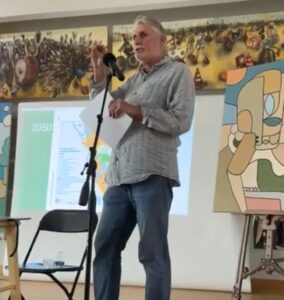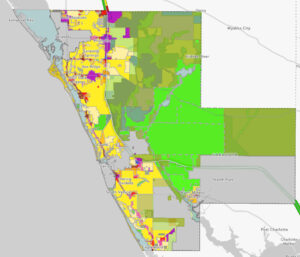Natural land has shrunk to 10% of the county’s map. What went wrong?
By Johannes Werner
Original Air Date: August 7, 2024
Host: Up to sometime early this century, Interstate Highway 75 was the eastern development boundary in Sarasota County. But then, environmentalists agreed with developers to a compromise that would allow certain construction east of the highway. Long story short: Today, there’s no more large-scale agriculture to speak of in this county, and as far as undeveloped areas go, we’re down to what local environmentalist Julie Morris calls the “Myakka Island”, with Myakka State Park at its core. Planning was supposed to keep all that from happening. So what went wrong? A series of broken promises, if you ask Jon Thaxton.
Johannes Werner: The former county commissioner began his presentation about mistakes made in planning with the natural history of Sarasota County, and the importance of the flatwoods.

Thaxton: The 2026 environmental lands referendum could safeguard the remaining 10% that still is natural land.
Jon Thaxton: These are flatlands areas. This is a picture of the prairie, very much like the Everglades, where the water has a great deal of residency time, meaning that it sits on the land. It has an opportunity to evaporate the plants that are there, has a chance to clean the water by removing the nitrates, removing the sediment. This is an area that was flooded two to three months out of the year. So if you can imagine, two-thirds or greater of Sarasota County, three fourths of Sarasota County was under three inches to a foot of water every year. Every year. We now look at flooding as this bad thing, this disastrous thing. But in fact, Sarasota County’s natural ecosystems are dependent upon this periodic flooding.
JW: Thaxton’s timing was impeccable. While he was talking on Saturday afternoon, the first downpours of Tropical Storm Debby began to saturate the ground outside. In the 48 hours following Thaxton’s talk, Debby dumped record amounts of rain, leaving the Celery Fields, about eight miles east of the Art Avenue Gallery, where Thaxton spoke to about 30 people, looking like a lake. The Celery Fields is a natural preserve that is now almost completely surrounded by new developments. With no other way to go but down the Philippi Creek, that water ended up flooding homes in the older Pinecraft and Bahia Vista and Tuttle neighborhoods waist-deep, forcing more than 500 people to evacuate. Flash floods even left some of the new subdivisions near the Celery Fields underwater.
On Monday, Tom Matrullo, one of the organizers of SCANPlan, the activist group that hosted Thaxton’s presentation, posted a photo of the flooded Celery Fields on Facebook. He pointed out that this is where the Sarasota County Commission is about to allow a national homebuilder to convert farmland into yet another subdivision.
But back to Thaxton. He described the history of urban expansion from core towns and cities that eventually connected along the coast. Then, he described the current explosion of development eastward, which he says is happening without a plan.

Comprehensive plan map. Thaxton describes the dark green areas as developable land in waiting.
JT: This uninterrupted sprawl has now consumed the entire coast, and now this three-front threat to Sarasota’s rural character is in high gear. The unincorporated Sarasota County is rapidly expanding to the east. The City of Venice, through the annexation of lands, is now moving not only north, but now it’s moving to the east. And the annexations of huge ranch lands in North Port are moving again to the north and also to the east.
JW: Florida state law since the 1970s has forced counties to create comprehensive plans. Sarasota created one after another. But each of them brought another concession. The 1989 plan, for instance, allowed development of all land west of I-75, in return for a guarantee that everything east of I-75 would not be allowed to develop.
Which brings us to the latest grand bargain. That was the 2050 plan, which passed in 2002, when Thaxton was chair of the county commission. He smuggled a bottle of champaign into the commission chambers to celebrate the near-unanimous passing of the 2050 plan, which put heavy restrictions on what could be built east of I-75. But it turned into what he called one of his biggest mistakes.
JT: If you go back and look at the 2050 commitments today, it reads like a tale of broken promises, the requirements for compact, walkable, non-gated, new urbanist communities with multiple integrated housing, including a mandate for affordable housing, are now gone. They’re just gone, and they’re replaced by the same old suburban sprawl that we’ve seen all along. Fiscal neutrality, the responsibility for developers to cover the infrastructure costs, such as roads, fire stations? They are now being subsidized. 2050, I like to describe as a Trojan horse, right? We let the horse behind the enemy gates, and as soon as nightfall came, all of the rules were changed, and we lost everything that we had worked for.
JW: The 2050 Plan’s biggest fallacy is that it turned agricultural land essentially into land in a holding pattern for development.
JT: All of the land that exists in Sarasota County’s comprehensive plan that is designated for agriculture today is not more than a holding pattern for future urban development. Mark my words. There is no agricultural preserve. There is no agriculture preserve area in our comprehensive plan. Do not trust it.
JW: So what does he suggest should be done to come out of this chain of broken promises? For one, know who to vote for.
Alex Coe, a Republican competing with developer-funded candidate Teresa Mast for the county commission’s District 1 seat, was eager to let her presence be known. She pointed out that Sarasota County has yet to create an advisory committee on agriculture and rural issues. She also expressed exasperation about the lack of accountability from county commissioners.
And then there’s the issue of environmentally sensitive lands. Those are the lands Julie Morris calls the “Myakka Island”. In two years, an environmental lands referendum is coming up, and we could choose to put the protection of the entire remaining 10% of the county’s land up for a vote.
JT: Already built or planned to be built in Sarasota County is 321,000 acres. Yet to be planned is the area in white, roughly 34,000 acres. That’s 10%. This is going to be an opportunity for us as voters, and those of us that are activists, to engage, get our neighbors engaged, and make sure that this referendum passes, because the only way that we’re going to be able to take some of that last remaining 10% land and add it into the column of preserve and protect it for future generations, is if that referendum passes.
In Sarasota, this has been Johannes Werner for WSLR News.
WSLR News aims to keep the local community informed with our 1/2 hour local news show, quarterly newspaper and social media feeds. The local news broadcast airs on Wednesdays and Fridays at 6pm.